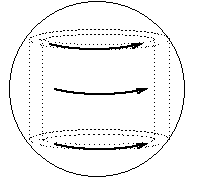

| MadSci Network: Astronomy |
The difference between "weather" and "climate" is important here. Climate is the year-to-year average of the atmosphere's state at a certain spot, while weather is the state on a certain day.
Saturn's atmosphere is composed mostly of hydrogen, with a little helium, just like Jupiter, Uranus, and Neptune. It has little or no solid ground inside: it's just a big ball of gas, held together by gravity. On Earth, we talk about the weather and climate at the surface, but inside Saturn, we must talk about climate at a certain height. We usually measure altitudes on Saturn from the solid deck of clouds covering the whole planet where the atmospheric pressure is 1.2 "bars" (a bar is the pressure of Earth's atmosphere at the ground.) These clouds are composed of ammonia droplets at a temperature of -125 Centigrade (-193 Farenheit). Saturn is very, very cold. Scientists believe it gets warmer as you go deeper into the planet.
Saturn has very strong winds, running east and west. The strongest winds blow from the east at 500 meters a second (1,100 miles an hour) near the equator. Wind speed gets smaller as you go north and south: in middle and high latitudes, there is a banded structure of alternating east and west winds. This banding is very much like the atmosphere of Jupiter. Jupiter has colored bands on its surface where the winds change: these exist, but are much fainter on Saturn. Here's a comparison of the two planets:

|

|
| Saturn | Jupiter |
Saturn's bands are more muted because they are deeper inside the planet than Jupiter's bands.
One unusual thing about Saturn's atmosphere is that the winds and clouds
on the southern hemisphere look just like the patterns on the northern
hemisphere. The physics which describes gas flow on moving planets says
that the winds probably extend clear through the planet, being the same
speed all along a series of cylindrical shells inside it, like this:

Like all the giant gas planets, Saturn has plenty of weather, in the form
of swirling storms that look like Earth's hurricanes and winter storms, but
which are probably created by a different process. This picture shows a
prominent storm in Saturn's clouds.

I got much of the information to answer this question from the Views of the Solar System page. This is the Saturn section.
Try the links in the MadSci Library for more information on Astronomy.